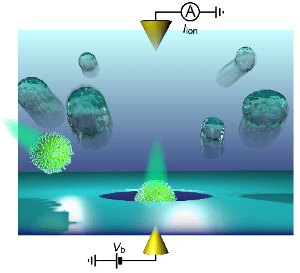Nov 22 2018
Influenza is a respiratory disease of global significance and is known to be highly contagious. Every year, it causes countless numbers of infections and carries the ubiquitous risk of a serious outbreak.
 Detection of a single influenza virion using a solid-state nanopore. (Image credit: Osaka University)
Detection of a single influenza virion using a solid-state nanopore. (Image credit: Osaka University)
Partial control of the virus is done through passive vaccination, which happens to be the only method available. In order to prevent outbreaks of influenza, rapid diagnosis of this infection has been investigated by giving medication during the very early stages of the disease, but despite this fact, diagnostic sensitivity has not been sufficiently high, until now.
In a recent study reported in Scientific Reports, researchers headed by Osaka University investigated the viability of integrating artificial intelligence technology with a single-particle nanopore sensor and discovered that this method was able to produce a new virus typing technique through which single influenza virions can be identified.
Many virus species can be identified with genetic methods; however, these methods need specialized staff and time-intensive procedures, which make them inappropriate for point-of-care screening. In the latest method, the investigators created a sensor with the potential to evaluate discrete nanoscale characteristics of influenza virions inside physiological samples.
We used machine-learning analysis of the electrical signatures of the virions. Using this artificial intelligence approach to signal analysis, our method can recognize a slight current waveform difference, which cannot be discerned by human eyes. This enables high-precision identification of viruses.
Makusu Tsutsui, Study Corresponding Author, Osaka University.
While testing this sensor, the team noted that electroosmotic flow—that is, liquid motion caused by an electric current across the nanopore—via the pore channel may prevent the non-virus particles from passing. This helped in making sure that only those particles assessed by the sensor were virus particles, irrespective of the intricacy of the sample containing those viruses.
Our testing revealed that this new sensor may be suitable for use in a viral test kit that is both quick and simple. Importantly, use of this sensor does not require specialized human expertise, so it can readily be applied as a point-of-care screening approach by a wide variety of healthcare personnel.
Akihide Arima, Study Lead Author, Osaka University.
This nanosensor method, apart from allowing the early detection of influenza, can possibly be altered to facilitate the early detection of other types of viral particles. Through this method, a wide range of potential pandemics and local epidemics can be rapidly tracked and prevented.